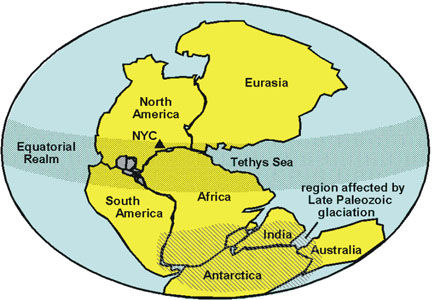New York Geology: Explore a Billion Years of Earth's History
by Betsy McCully
Updated July 10, 2025

Manhattan's Ancient Bedrock
Imagine a skyline of sky-scraping mountain peaks! New York City’s bedrock tells the story of continents colliding, fusing, and rifting apart over a period of a billion years.
The bedrock that anchors Manhattan’s skyscrapers was formed between 450 million and over a billion years ago. Manhattan is built on three strata known as Manhattan Schist, Inwood Marble, and Fordham Gneiss. Schist forms the island’s spine from the Henry Hudson Bridge on its north end to the Battery on its southern tip; it dips abruptly several hundred feet below ground at Washington Square, and makes a gradual ascent beginning at Chambers Street. These dips and rises account for the gap between “Midtown” and “Downtown” in the Manhattan skyline, since tall buildings had to be anchored on solid bedrock and not on the glacial till that fills the valleys.
Manhattan Schist is a metamorphic rock formed around 450 million years ago when continents collided, pushing up mountains high into the sky. This was the Taconic Orogeny. By around 300 million years ago, earth’s continents fused into a supercontinent called Pangaea. Inwood Marble is metamorphosed limestone formed around the same time as the Manhattan Schist. Ranging from 150 to 500 feet thick, the marble strata form the bedrock beneath the Harlem River, East River and adjacent regions; the marble strata erupt above ground as a ridge that extends from Dyckman Street on Manhattan’s Upper West Side northward to Marble Hill at Manhattan’s northern tip. Fordham Gneiss is a metamorphic rock formed when ancient granite bedrock was subjected to intense heat over a billion years ago during the Grenville Orogeny. Half a billion years later, during the Taconic Orogeny, the granite bedrock was overthrust and interlayered with the schist and marble strata, forming the Manhattan Prong. Fordham Gneiss forms the Riverdale and Grand Concourse ridges in the Bronx.


Manhattan Schist, Inwood Marble, and Fordham Gneiss are the three strata of Manhattan’s bedrock. They are by no means arranged in simple layers like the leaves of a book but are complexly interfolded. They shape Manhattan’s topography.

Where to See New York City's Bedrock
Manhattan



The Bronx

New Jersey Palisades
New York Geology Reading List
New York Geology links
c. Betsy McCully 2018-2025
